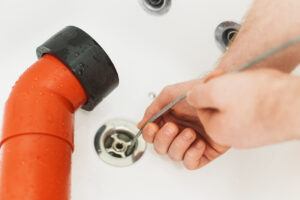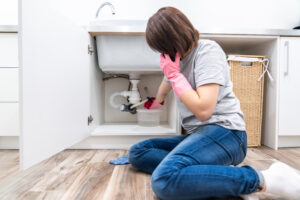Just like the house in which we live, mildew formation in a well pump house can present almost the same challenges. Well, some people might argue that they practically do not live there.
While this can never be further from the truth, remember you will be visiting the place very often. Exposure to mildew during those many visits can have adverse safety and health issues.
From accidents through slippery surfaces caused by mildew, irritable eyes, all manner of allergies, and respiratory problems, to structural degradation, mildew can present so many challenges that can be avoided.
The worst-case scenario is when moisture buildup corrodes the pump parts and causes its complete breakdown.
You would be forced to replace the pump, which can be cost demanding. This article gives information regarding the best methods to keep your pump house dry and mildew-free.

Well pump serviced to keep your house dry
Drainage
Usually, most moisture-related issues in pump houses are caused by water from the exterior. Yard runoff water can find its way into the pump house and result in moisture buildup and this will automatically cause mildew formation. To combat this, grade your yard in a way that runoff water drains away from the pump house instead of going in its direction. However, for the water coming from the well itself, consider installing French drains to take away the water toward the yard. French drains are simply trenches filled with gravel and a perforated pipe meant to trap floor water before losing it to the yard. Sometimes drainage installation in pump houses may not be feasible, due to the scope of work. In this case, a sump pump can be used to suck the floor water and discard it.
Insulation
Another hack that often goes overlooked is the insulation of the room. With properly insulated pump house walls, exterior temperature fluctuations will never present moisture issues indoors. As you go about insulating the house walls, remember to seal all the spaces, crevices and cracks, especially around the door and vents using spray foam. It will also help prevent the rain from penetrating inside the house.
Regular Inspection and Cleaning
Another crucial solution for mildew in pump houses that tends to be overlooked is the regular inspection and cleaning of the area. Besides moisture buildup, the next major cause of mildew formation is dirt, which is prevalent in most pump houses. With regular inspection, you will easily notice small mildew formations and exterminate them before they escalate to serious problems. Maintaining high cleanness standards also entails the removal of clutter that introduces darkness, which is a main catalyst for mildew formations.
Ventilation
The electrical components of the well pump emit some energy in the form of heat. Without proper circulation, that heat will remain in the house and will be converted to moisture when it condenses during the cold months. To improve aeration and prevent condensation, consider installing ventilation such as vents to allow the heat to escape. Alternatively, you can install a mini exhaust fan to rid the pump house of any moisture formation, which may lead to the formation of mildew.
Dehumidifier
The fact that you do not live there, simply means the house may never be completely moisture-free. Even with ventilation, and all water issues addressed, heat from the surroundings, especially during hot summer months, can find its way here. Upon getting here, it will be converted to moisture when the indoor temperatures drop at night. This moisture leads to mildew challenges. To prevent this scenario, consider installing a dehumidifier. This has the ability to collect all the available moisture from the air and convert it to water that usually collects in a tank. During the first days of installing a dehumidifier, you will be required to empty the tank more often as the moisture levels are still high. However, the levels will gradually decrease in the future.
Repair Water Leaks
Another great hack for ridding your pump house of moisture and mildew challenges is by ensuring that water connections are tightly done and that there are no leaks. Since water connections are many, even the smallest leaks can to a massive accumulation of water that will automatically cause mildew formations. To combat this challenge, replace the worn-out thread tapes, use a wrench to tighten the joints, and spray insulation foam around cracks and crevices.
By following the above-discussed guidelines, you can achieve a dry pump house and remain safe from mildew exposure. Eliminating mildew plays a crucial role in extending the lifespan of the well pump by protecting the moving parts from corrosion.




